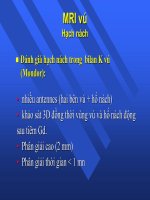MSK mri
Bạn đang xem bản rút gọn của tài liệu. Xem và tải ngay bản đầy đủ của tài liệu tại đây (7.71 MB, 81 trang )
Musculoskeletal MRI
Goals
► What
types of MR studies are available for
evaluation of the musculoskeletal system?
► Considerations when ordering a study
Remember one of the roles of the radiologist is as
consultant to work with you in determining the best study
for the patient’s needs (it’s in the job description)… talk to
them!
► Most
common pathologies for which MSK
MRI is performed
Exam Types
► MRI
without contrast
Most common
Evaluation of ligaments, tendons, occult fracture, cartilage
► MRI
with contrast
Evaluation of bone or soft tissue tumor, osteomyelitis,
abscess
► MR
Arthrogram
Evaluation of labrum, intercarpal ligaments
Body Part
► When
ordering any study must have a ddx
in mind, particularly with MRI (not a
screening tool)
► Cannot perform an MRI of a whole extremity
(time, pt motion, protocol issues)
► Must identify part to be imaged – be specific
A joint, a bone (prox, mid, distal), a muscle (origin, belly,
insertion)
► Must
have plain radiograph
Most Common Indications
►
►
►
►
►
►
►
Occult fx or stress fx
Early osteonecrosis – in pt with risk factors & pain,
known AVN of one hip
Osteomyelitis – plain film is insensitive (30-50% loss of bone
density) BUT necessary for MRI interpretation, nucs has
poor resolution
Osteochondral lesion – evaluate stability
Ligament/tendon injury – knee, shoulder, ankle > other
jts
Bone tumor – MUST HAVE X-RAY 1st, imperative in
providing ddx on MRI (dx on x-ray, determine extent on
MR)
Soft tissue mass/muscle injury
Considerations when ordering
an MRI
►
►
►
►
►
►
►
Joint replacement in joint of interest – don’t do it
Pacemaker – don’t do it
Claustrophobia - sedation
Unable to hold still/follow instructions – sedation
Metal in area of interest (susceptibility artifact) –
consult radiologist, may vary technique or
recommend another study
Metal not in area of interest ie. orbits (motion,
overheating)
If you only remember one thing, remember this:
cannot do a PE protocol chest CT without contrast
Metal Artifact
Small metal foreign body
results in large area of signal
void.
Metal or gas = black hole.
General Principles
► Fluid,
edema, inflammation is bright on T2
► Fat is bright on T1 & T2 (can have fat sat)
► Blood is often bright on T1
► Tendons & ligaments are black on all
sequences
► Cartilage is bright on T2
► Muscle is intermediate in signal
Pelvis & Hip – Normal
Anatomy
► Joints
– sacroiliac, pubic symphysis, hips
► Tendons – iliopsoas, gluteal, hamstrings,
rectus femoris
► Bursa – trochanteric, iliopsoas
► Bones – evaluate for bone marrow replacing
process (MM, mets), AVN, occult or stress fx
► Acetabular labrum – need intra-articular
gadolinium
Femoral Head Osteonecrosis
► Groin
pain
► Many predisposing factors: trauma (fem neck
fx, dislocation), steroids, SLE, sickle cell dz,
pancreatitis, alcohol abuse, Gaucher’s dz
► Increased risk of contralateral AVN, must
evaluate other side, most sensitive study is MRI
► MRI:
Early – bone marrow edema
Later – geographic area of abnormal signal in the
anterosuperior femoral head; double line sign on T2
Even later – subchondral collapse, femoral head
collapse, degenerative joint dz
Femoral Head Osteonecrosis
the other hip – 40% bilateral
Anterior and superior femoral
head
More examples of AVN
and more…
Triple line
sign?
Labral Tear
► Clicking,
locking, pain with pivoting/twisting
► Traumatic (young), degenerative (older) or
assoc. with femoroacetabular impingement
(middle-aged)
► MRI:
Anterosuperior or posterosuperior
Linear high T2 signal
Loss of triangular morphology
Paralabral cyst
► MR
arthrogram most sensitive study –
contrast fills tear
Knee – Normal Anatomy
► Anterior
& posterior cruciate ligaments
► Medial & lateral menisci
► Medial collateral ligament
► Lateral ligamentous complex (lateral
collateral, iliotibial band, biceps femoris)
► Extensor mechanism
► Normal variant (discoid meniscus)
Knee – Normal Anatomy
ACL Tear
►
►
Sports injury, rapid stopping/starting/pivoting
(skiing, soccor, football, basketball etc), anterior
drawer sign on PE
MRI:
►
►
Disruption of fibers, high signal on T2
Pivot-shift contusions
Anterior translation of tibia relative to femur
Associated with MCL and medial meniscus injury –
O’Donahue’s unhappy triad
Associated with Segond fx (avulsion of mid third
lateral capsular ligament from lateral tibial plateau)
ACL Tear
ACL Tear – Pivot shift
contusion
PCL Tear
► Dashboard
injury of flexed knee, posterior
drawer sign on PE
► MRI:
Disruption of fibers/thickened fibers
Abnormal high T2 signal
Avulsion at insertion on posterior tibia
PCL Tear
Meniscal Tear
► Joint
line tenderness,
clicking, locking
► MRI:
High T2 signal in the
meniscus extending
to the articular
surface
longitudinal, radial,
flap (flipped), oblique,
bucket-handle
Parameniscal cyst
Oblique Undersurface Tear w/
Parameniscal Cyst
Bucket-handle Tear
► Medial
> lateral
► Diminutive
meniscus
► Inner edge of
meniscus is
displaced medially
into notch
► Double PCL sign









